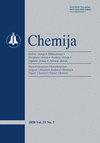2-氨基-6-(芳基氨基甲基)噻吩[2,3-d]嘧啶-4(3H)-酮的合成及二氢叶酸还原酶抑制活性
IF 0.4
4区 化学
Q4 CHEMISTRY, MULTIDISCIPLINARY
引用次数: 0
摘要
本研究主要从卡氏肺囊虫(pc)、刚地弓形虫(tg)和鸟分枝杆菌(ma)等条件微生物中合成和评价作为二氢叶酸还原酶(DHFR)潜在抑制剂的新化合物。设计并合成了一组6亲脂性和1经典的硫代[2,3-d]嘧啶系列抗叶酸药,其具有DHFR抑制剂的关键药效特征,并具有连接芳香部分和2-氨基-4-氧硫代[2,3-d]嘧啶核的氨基甲基桥。结果表明,2-氨基-6-[(4-甲氧基苯基氨基)-、6-[(4-氯苯氨基)-和6-[(2,5氯苯氨基)甲基]噻吩[2,3-d]嘧啶-4(3H)-对pcDHFR具有中等抑制活性(IC50分别为56.5、49.9和23 μM)。这些化合物对tgDHFR的IC50分别为6.0、2.8和2.3 μM,与甲氧苄啶的IC50为2.7 μM相当。合成的亲脂性抗叶酸剂未显示对maDHFR的活性。经典的抗叶酸剂2-{4-[(2-氨基-4-氧-3,4-二氢噻吩[2,3-d]嘧啶-6-基)甲胺]苄胺}- l -谷氨酸对所有微生物的DHFRs均有抑制作用(IC50对pcDHFR为6.6 μM,对tgDHFR为1.06 μM,对maDHFR为16.9 μM)。本文章由计算机程序翻译,如有差异,请以英文原文为准。
Synthesis and dihydrofolate reductase inhibitory activity of 2-amino-6-(arylaminomethyl) thieno[2,3-d]pyrimidin-4(3H)-ones
The present work deals with synthesis and biological evaluation of novel compounds as potential inhibitors of dihydrofolate reductase (DHFR) from opportunistic microorganisms – Pneumocystis carinii (pc), Toxoplasma gondii (tg) and Mycobacterium avium (ma). A set of 6 lipophilic and 1 classical antifolates of thieno[2,3-d]pyrimidine series were designed and synthesised with key pharmacophoric features of DHFR inhibitors and aminomethylene bridge joining the aromatic part and 2-amino-4-oxothieno[2,3-d]pyrimidine nucleus. Investigation of the DHFR inhibitory activity of the synthesised compounds revealed that 2-amino-6-[(4-methoxyphenylamino)-, 6--[(4-chlorophenylamino)- and 6-[(2,5 ichlorophenylamino)methyl]thieno[2,3-d]pyrimidin-4(3H)- ones had a moderate activity (IC50 56.5, 49.9 and 23 μM, respectively) against pcDHFR. Activity of those compounds against tgDHFR (IC50 6.0, 2.8 and 2.3 μM, respectively) was comparable to that of trimethoprim (IC50 2.7 μM). No synthesised lipophilic antifolates showed activity towards maDHFR. The classical antifolate 2-{4-[(2-amino-4-oxo-3,4- dihydrothieno[2,3-d]pyrimidin-6-yl)methylamino]benzamido}-L-glutamic acid inhibited DHFRs from all microorganisms (IC50 6.6 μM for pcDHFR, 1.06 μM for tgDHFR and 16.9 μM for maDHFR).
求助全文
通过发布文献求助,成功后即可免费获取论文全文。
去求助
来源期刊

Chemija
化学-化学综合
CiteScore
1.30
自引率
16.70%
发文量
14
审稿时长
>12 weeks
期刊介绍:
Chemija publishes original research articles and reviews from all branches of modern chemistry, including physical, inorganic, analytical, organic, polymer chemistry, electrochemistry, and multidisciplinary approaches.
 求助内容:
求助内容: 应助结果提醒方式:
应助结果提醒方式:


